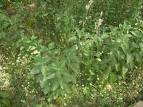Ashwagandha
Vithania somnifera Solanaceae Also called Withania. A native of tropical India, shwagandha forms a bush that can ach 1.2m in height. The plant as been used in traditional Indian 1edicine for more than 2000 years. ts Sanskrit name means 'the thing hat has the smell if a horse' riference to the horse's strength nd vitality rather than its odour. t is also said to be an aphrodisiac nd beniificial in infertility. Its 'yellowy green flowers give way to gleaming red berries. Parts usedRoots These are harvested in autumn, Iried, then cut up for use in lecoctions, capsules of the powder, inctures, and liquid or dry extracts. ConstituentsThe ashwagandha root is notable for j steroid called withanolide, which is anti-inflammatory. It also contains jlkaloids, particularly withasomnine, :hat are responsible for the root's ,sedative qualities. Medicinal usesAshwagandha has traditionally been rescri bed as a ton ic. Th is use was ;upported by a paper published in :he Journal of Ethnopharmaco/ogy in 2000, which described how the plant lelps the body to cope with and adapt to stressful situations. It also lowers blood pressure, slows the heart rate and boosts the immune system. In Indian medicine Ashwagandha is commonly prescribed to help convalescing patients to overcome fatigue. The plant is also used to treat anxiety and nervous problems and in large doses can induce sleep. Research performed in America in 1991 found that ashwagandha contains components that act in the same way as the main inhibitory neurotransmitter in the central nervous system. It is this that is likely to account for its sedative and sleepinducing qualities. Painful rheumatic joints respond to its anti-inflammatory properties and its high iron content makes it useful in the treatment of anaemia. CAUTIONSWomen who are pregnant or )reastfeeding should not use this plant. Avoid taking barbiturates and )ther tranquillisers when using ashwagandha. CultivationPlant in dry, stony soil, preferably in the sun or light shade. PREPARATION AND DOSAGEfor Internal Use TO TREAT fatigue, rheumatic joints TINCTURE (1:3 in 45% alcohol) put 20 drops into a glass of water. Take three times a day. TO TREAT insomnia, anxiety, nervous problems CAPSULES (250mg) Take 2-3 capsules, twice a day. IF SYMPTOMS PERSIST CONSULT A DOCTOR |
Ayurveda Book
This book on Ayurveda is meant for people interested to know about basics concepts of Ayurvedic healing and learn ayurveda concepts. Though there are many books Read More My SitesReal Testimonials
Connect with us |







